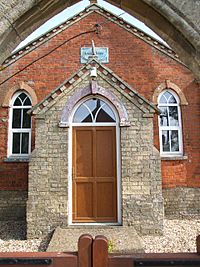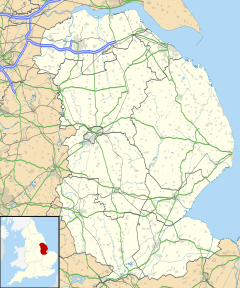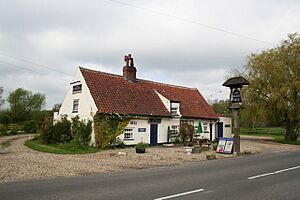Tattershall Thorpe facts for kids
Quick facts for kids Tattershall Thorpe |
|
|---|---|
 Wesleyan Chapel, Tattershall Thorpe |
|
| Population | 245 (2011) |
| OS grid reference | TF219594 |
| • London | 110 mi (180 km) S |
| District | |
| Shire county | |
| Region | |
| Country | England |
| Sovereign state | United Kingdom |
| Post town | Lincoln |
| Postcode district | LN4 |
| Police | Lincolnshire |
| Fire | Lincolnshire |
| Ambulance | East Midlands |
| EU Parliament | East Midlands |
| UK Parliament |
|
Tattershall Thorpe is a small village in the East Lindsey area of Lincolnshire, England. It is about 3 miles (5 km) south of Woodhall Spa and 1 mile (1.6 km) northeast of Tattershall. This village is well-known for its important connection to RAF Woodhall Spa during the Second World War.
Contents
RAF Woodhall Spa: A Historic Airfield
RAF Woodhall Spa was an important air base that helped RAF Coningsby. Building started in 1940. However, it was paused because of the war. Construction began again in 1942, and the airfield opened later that year.
The base had three concrete runways. It also had aircraft hangars and temporary homes for over 1,000 airmen. Since it was meant for large bomber planes, there were also big bomb storage areas. These were located north of the flying field.
Famous Squadrons at Woodhall Spa
The airfield was mainly used by two famous groups of planes:
- 97 Squadron
- 617 Squadron, also known as the "Dambusters"
Later in the war, 617 Squadron dropped very powerful "Grand Slam" bombs. After the war, planes stopped flying from the base. But it was used again from 1960 to 1967 for Bristol Bloodhound Missiles. In 2000, part of the site was still used by the RAF to test aircraft engines.
Thorpe Camp: A Wartime Museum
Thorpe Camp was once part of RAF Woodhall Spa. It was built in 1940 to house airmen. After the war, the local council used it for temporary homes until the 1960s.
By the late 1980s, the camp was falling apart. It was almost torn down. But then, the Thorpe Camp Preservation Group stepped in. This group is a charity. They first rented and then bought the site. Now, they run the Thorpe Camp Visitor Centre. It has museum exhibits in the old buildings.
The Bluebell Inn: A Pub with History
The Bluebell Inn is a very old pub. It dates back to about 1257 AD. It became an inn in the 1600s. It has been changed a bit in the 1800s and 1900s. The building is made of "mud and stud" (a traditional building method) and has brick at the bottom.
It is a Grade II listed building, which means it's an important historic place. Inside, you can find items from RAF Woodhall Spa. This was an active RAF base during the Second World War. The ceiling of The Bluebell Inn has signatures from many RAF members. These include airmen from 97, 619, 617 (the Dambusters), and 627 Squadrons. They used to visit the pub often. Even today, RAF personnel from the Battle of Britain Memorial Flight and other squadrons from RAF Coningsby sign the ceiling to keep the tradition going. Wing Commander Guy Gibson, who led the famous 1943 "Dam Busters" raid, visited the pub many times before he passed away in September 1944.
Anglo-Saxon Smith’s Burial: An Ancient Discovery
In 1981, an old burial site was found in Tattershall Thorpe. It was from the Anglo-Saxon period, around the 600s. The burial was laid out from east to west.
It contained tools used by a smith. These included an anvil and other smith's equipment. There were also bells found. These bells might have been used to show that a stranger was nearby. This burial suggests that smiths might have been seen as different or outside the main group in their time.
Population Changes in Tattershall Thorpe
The number of people living in Tattershall Thorpe has changed over the years. Here is a look at the population from 1891 to 2011:
| Population of Tattershall Thorpe Civil Parish, 1891- 2011 | |||||||||||
|---|---|---|---|---|---|---|---|---|---|---|---|
| Year | 1891 | 1901 | 1911 | 1921 | 1931 | 1951 | 1961 | 2001 | 2011 | ||
| Population | 277 | 233 | 222 | 213 | 196 | 482 | 178 | 264 | 245 | ||



